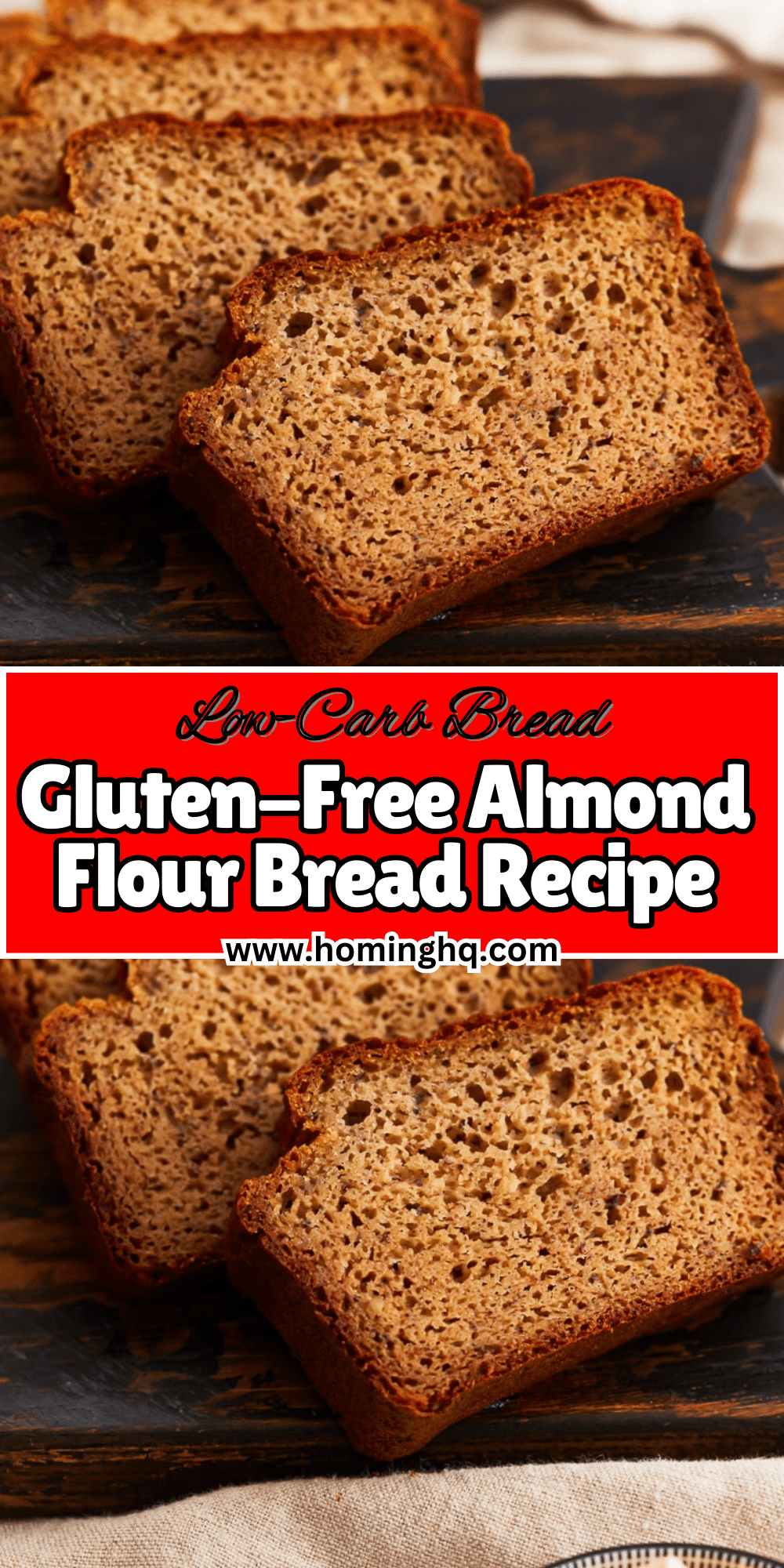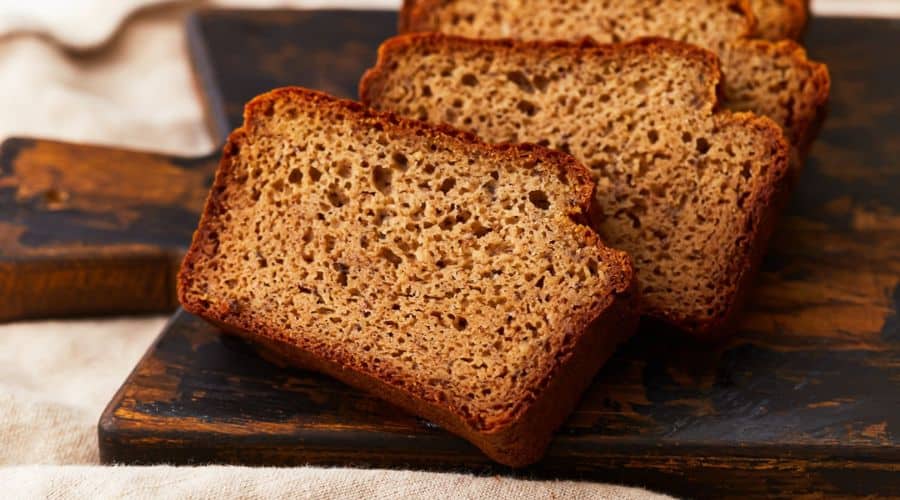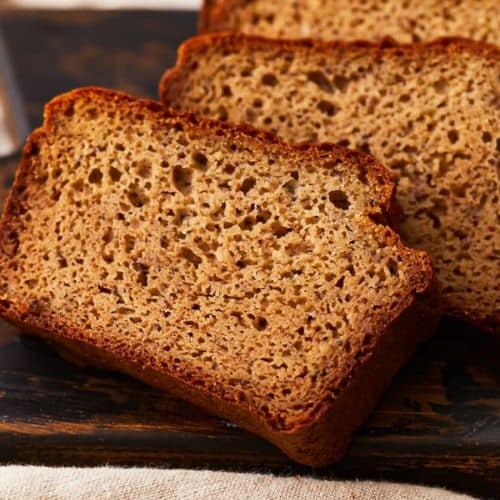Making gluten-free almond flour bread is a great way to enjoy the comfort of homemade bread without the gluten.
Whether you’re avoiding gluten for dietary reasons or simply looking for a healthy alternative, almond flour bread provides a rich and flavorful option.
This recipe is easy to follow and results in a soft, moist loaf that’s perfect for sandwiches, toast, or just enjoying on its own.

What is Almond Flour?
Almond flour is made from finely ground blanched almonds, making it a gluten-free and low-carb alternative to traditional wheat flour.
It’s naturally high in protein, healthy fats, and fiber, which makes it a great choice for those following a low-carb or paleo diet.
Almond flour is often used in baking recipes to provide a rich, nutty flavor and moist texture.
Key Ingredients for Gluten-Free Almond Flour Bread
The ingredients for this bread are simple, yet essential to achieve the perfect texture and flavor. You’ll need:
- Almond Flour: The star ingredient that will provide moisture and flavor.
- Baking Powder: To help the bread rise and create a light, fluffy texture.
- Eggs: Eggs help bind the ingredients and provide structure.
- Olive Oil or Melted Butter: Adds richness and moisture to the bread.
- Honey or Maple Syrup: A touch of natural sweetness to balance the flavors.
- Salt: To enhance the taste of the bread.
Equipment You’ll Need
To make the process smoother and ensure success, gather the following equipment:
- Mixing Bowls: To combine your dry and wet ingredients.
- Whisk or Hand Mixer: For mixing the ingredients.
- Loaf Pan: A 9×5-inch loaf pan works best for this recipe.
- Parchment Paper (optional): To prevent sticking and for easy removal of the loaf after baking.
- Oven: Preheat to 350°F (175°C) to ensure even cooking.
Step-by-Step Instructions for Making Gluten-Free Almond Flour Bread

- Preheat the Oven: Start by preheating your oven to 350°F (175°C). Grease your loaf pan or line it with parchment paper.
- Mix Wet Ingredients: In a large mixing bowl, whisk together the eggs, olive oil (or melted butter), and honey or maple syrup until well combined.
- Add Dry Ingredients: In a separate bowl, mix together the almond flour, baking powder, and salt.
- Combine Wet and Dry: Gradually add the dry ingredients to the wet mixture, stirring gently to avoid lumps. The dough will be thick but should easily come together.
- Pour into Pan: Transfer the batter into your prepared loaf pan and spread it evenly.
- Bake: Place the loaf pan in the preheated oven and bake for 30-40 minutes, or until the bread is golden brown and a toothpick inserted in the center comes out clean.
- Cool and Serve: Allow the bread to cool in the pan for 10 minutes, then transfer it to a wire rack to cool completely. Slice and enjoy!
Tips for Perfect Gluten-Free Almond Flour Bread
- Check Consistency: If the batter seems too thick, you can add a small amount of water or almond milk to achieve the right consistency.
- Use Fresh Almond Flour: For the best texture and flavor, make sure your almond flour is fresh and hasn’t been sitting in your pantry for too long.
- Don’t Overmix: Overmixing the dough can cause the bread to become dense. Mix just until the ingredients are combined.
- Let it Cool: Be patient and allow the bread to cool completely before slicing. This will help maintain its structure and texture.
Variations and Customization Ideas
One of the best things about gluten-free almond flour bread is how adaptable it is. Here are a few ideas to make it your own:
- Add Seeds or Nuts: For extra texture, consider adding sunflower seeds, chia seeds, or chopped walnuts to the batter.
- Herbs and Spices: Experiment with adding herbs like rosemary or thyme for a savory twist. Cinnamon or nutmeg can add warmth and depth for a sweet version.
- Dairy-Free Version: Swap the butter for coconut oil or use a dairy-free yogurt for added moisture if you’re following a dairy-free diet.
- Make It Sweet: Add dried fruits like cranberries, raisins, or even chocolate chips for a sweeter loaf. You can also increase the amount of honey or maple syrup for more sweetness.
- Zest it Up: Adding citrus zest (such as lemon or orange) can bring a refreshing and aromatic flavor to the bread.
Serving and Storing Your Gluten-Free Almond Flour Bread
- Serving Suggestions: This almond flour bread can be enjoyed in many ways. Toast a slice and top it with your favorite spread, such as almond butter, avocado, or a drizzle of honey. It’s also great for sandwiches, pairing well with both savory and sweet fillings.
- Storing: Store the bread in an airtight container at room temperature for up to 3 days. If you’d like to keep it fresh for longer, slice and freeze the loaf. To serve, simply toast or warm slices as needed.
- Freezing: Almond flour bread freezes well. Wrap individual slices in plastic wrap or wax paper and place them in a freezer-safe bag. This allows you to pull out a slice whenever you’re craving fresh, gluten-free bread.
Conclusion
Gluten-free almond flour bread is a delicious, healthy alternative to traditional bread that’s simple to make and full of flavor. Whether you’re following a gluten-free diet or just want to try something new, this recipe is a great choice for a nutritious loaf. With endless customization options, you can make it your own, and it stores well for those times when you need a quick, easy snack. Enjoy your homemade almond flour bread fresh, toasted, or in your favorite sandwiches!
Frequently Asked Questions
- Can I use another type of flour instead of almond flour? While this recipe is specifically designed for almond flour, you can experiment with other gluten-free flours like coconut flour. However, keep in mind that substitutions may affect the texture and moisture content.
- Can I make this bread without eggs? Yes, you can substitute the eggs with a flax egg (1 tablespoon ground flaxseed mixed with 3 tablespoons water, let sit for a few minutes to thicken) or another egg replacer. The texture may change slightly, but it should still work.
- Can I make this bread in a bread machine? This recipe is designed for traditional baking in the oven. A bread machine may not be suitable, as the batter is thicker and does not have the same consistency as typical bread dough.
- How can I make the bread rise more? If you want the bread to rise more, you can try adding an extra teaspoon of baking powder or a pinch of baking soda. You could also let the dough rest for about 10 minutes before baking to help it rise slightly.
- Why did my bread turn out dense? If the bread turned out dense, it could be due to overmixing the batter, using old baking powder, or not letting it cool completely before slicing. Make sure to follow the recipe instructions carefully and allow the bread to cool fully for the best results.

Gluten-Free Almond Flour Bread
Equipment
- 1 9×5-inch loaf pan
- 1 Mixing Bowl (for wet ingredients)
- 1 Mixing Bowl (for dry ingredients)
- 1 Whisk or hand mixer
- 1 measuring spoons
- 1 Measuring cups
- 1 Parchment paper (optional)
- 1 Oven (for baking)
Ingredients
- 2 cups Almond flour
- 1 ½ teaspoons Baking powder
- ¼ teaspoon Salt
- 3 large Eggs
- ¼ cup Olive oil or melted butter
- 2 tablespoons Honey or maple syrup
Instructions
- Preheat the oven to 350°F (175°C) and grease or line your loaf pan with parchment paper.
- Mix the wet ingredients: In a large bowl, whisk together the eggs, olive oil (or melted butter), and honey or maple syrup until smooth.
- Mix the dry ingredients: In another bowl, combine the almond flour, baking powder, and salt.
- Combine wet and dry: Gradually add the dry ingredients to the wet mixture, stirring until everything is well combined.
- Transfer the batter to your prepared loaf pan and smooth the top evenly.
- Bake for 30-40 minutes or until the bread is golden and a toothpick inserted comes out clean.
- Cool: Allow the bread to cool in the pan for 10 minutes, then transfer to a wire rack to cool completely before slicing.
Notes
- Storage: Store in an airtight container at room temperature for up to 3 days. For longer storage, freeze individual slices.
- Moisture: If your batter seems too thick, add a little bit of water or almond milk to reach the right consistency.
- Customization: Feel free to add seeds, nuts, or herbs for extra flavor and texture. Adjust the sweetness by adding more honey or maple syrup if desired.

